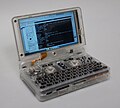History of video games/Platforms/DragonBox Pyra
-
A render of the Pyra.
History
[edit | edit source]Development
[edit | edit source]
Following the release of the OpenPandora console, a member of the Pandora development team began developing a spiritual successor console in 2014. During development, several processors were considered, including those from Qualcomm and Intel.
Preorders for the Pyra began in 2016.[2] Pre-orders cost 500 euros or US$580. At least 700 preorders were placed by May 3, 2016, allowing production to be funded.[3]
Pre-Production prototypes were shipped in late 2019. By 2020 hardware development was finalized, and development efforts began to focus on finalizing software.
An art book containing 48 pages and chronicling the development of the console was made to be included with shipped units.[4]
On December 24, 2020 photos of subassemblies were shared.[5][6]
Technology
[edit | edit source]
Technology choices are typically driven by performance, cost, or portability in most handheld consoles. The Pyra bucks that trend, making choices that emphasize upgradability, maintainability, and compatibility with an open source ecosystem. Thus while the Pyra had underwhelming performance for the time it was announced, it had other qualities not found in competing handhelds which were desirable to the niche audience it was marketed to.
Compute
[edit | edit source]The Pyra is powered by a Texas Instruments OMAP 5 SoC containing two ARM Cortex A-15 cores clocked at 1.5 gigahertz, two ARM Cortex M4 cores, a PowerVR SGX544-MP2 3D GPU, and a Vivante GC320 2D graphics accelerator.[7]
Depending on the unit, a Pyra either has two gigabytes of RAM or four gigabytes of RAM.[7] All Pyras have 32 gigabytes of eMMC, an internal microSD card slot, and two external SD card slots.[7]
Hardware
[edit | edit source]The mainboard, CPU board, and display board are all fitted in modules for easy replacement or upgrades. This makes the Pyra relatively unique among consoles, as few home consoles offer such modularity, and among handheld game consoles this is nearly unheard of.
The Pyra uses a 5" LCD touchscreen with a resolution of 1280 pixels by 720 pixels.[7] The touchscreen is resistive,[7] allowing for use through gloves and other non conductive surfaces, though lacking the finger oriented optimizations of capacitive touchscreens.
The system contains a vibration motor, gyroscope and an accelerometer.[7]
The Pyra uses a 6000 mAh battery.[7]
Radios include 2.6 gigahertz and 5 gigahertz WiFi a/b/g/n, and Bluetooth 4.1.[7] An optional 3G/4G/UMTS + GPS module is included on some units,[7] allowing for the system to make use of mobile data and make use of the global positioning system for location information.
Notable games
[edit | edit source]As of 2020 the Game category of the DBP (DragonBox Pyra) repository had 19 entries.[8]
Gallery
[edit | edit source]External Resources
[edit | edit source]References
[edit | edit source]- ↑ "Legal Information". Official Pyra and Pandora Site. Retrieved 7 December 2020.
- ↑ Singleton, Micah (2 May 2016). "The DragonBox Pyra is now available for preorders". The Verge. Retrieved 15 November 2020.
- ↑ "Twitter". Retrieved 25 December 2020.
- ↑ "48 Pages Mini-Artbook with development history.". https://twitter.com/EvilDragon1717/status/1337355551538286592.
- ↑ "140 Dark Chrome Display frames". Retrieved 25 December 2020.
- ↑ "Evil Dragon Twitter". Retrieved 25 December 2020.
- ↑ a b c d e f g h i "Technical Specifications". Retrieved 5 November 2020.
- ↑ "Apps - DBP repository". www.pyra-handheld.com. Retrieved 15 November 2020.
























